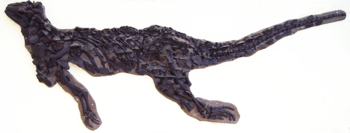Black Ven
Black Ven is a cliff in Dorset, England. It is part of the Jurassic Coast World Heritage site. The cliff is famous for its mudslides, in fact, it has the largest mudslides in Europe. The area is popular with tourists because a number of fossils are found in the area.
History

The Black Ven has been historically renowned for paleontology. Mary Anning found an ichthyosaurus in The Spittles, and James Harrison found the first fossil remains of a Scelidosaurus while quarrying Black Ven in 1858. In 2001, the Black Ven and the whole of Lyme Bay became part of the Jurassic Coast World Heritage Site.
Geography
Black Ven is situated between the Dorset towns of Charmouth and Lyme Regis. The cliffs reach a height of 130m. Golden Cap, a few miles East, is the highest point on the South coast of England at roughly 191m above sea level. Also nearby is an undercliff where the famous Ammonite pavement is. Slightly east is the town of Charmouth, where the heritage centre lies.
Geology
Black Ven has the largest mudslides in Europe, this constantly brings new material (such as fossils) to the base of the cliff and beach. The reason for this is the types of stone found through the cliff. There is porous limestone, which lets the water on rough days flow through it, below which you will find clay, which lets water in, but not out. When the clay becomes saturated, it becomes very slippery and the limestone above can slide off in large chunks. Black Ven for this reason is a famous fossil hunting location, although the mudslides can be surprisingly damaging to the fossils, especially to soft parts such as scales. The Black Ven has a layer called Blue Lias where famous fossilised fish are known to be found. The geological dating of the rocks of the whole of the area (Lyme Bay) is Jurassic. The Black Ven and the Spittles contain rocks from the lower (early) Jurassic. Ammonites, Belemnites, and the occasional Devil's toenail are common finds in this area.
Tourism
Lyme Bay is renowned for its fossil finds. So it is not surprising that there are plenty of tourists trying to discover the next best find. Charmouth has a number of facilities for tourists, including two reasonably large car parks, cafés, shops (including the famous fossil shop) and tours around Lyme Bay for fossils.
References
- Clarke, Nigel J. (2004) Lyme Bay Fossils: Jurassic Beach Guide. Nigel J. Clarke Publications. ISBN 978-0-907683-01-8
External links
See also
- Geology of Dorset
- For further Jurassic sites see: List of places on the Jurassic Coast
Coordinates: 50°44′03″N 2°54′39″W / 50.7342°N 2.9107°W